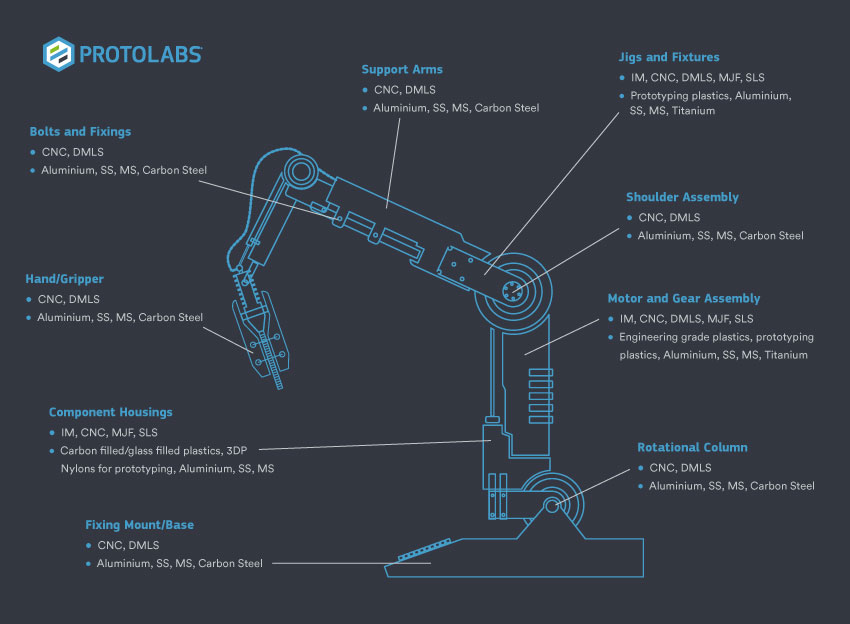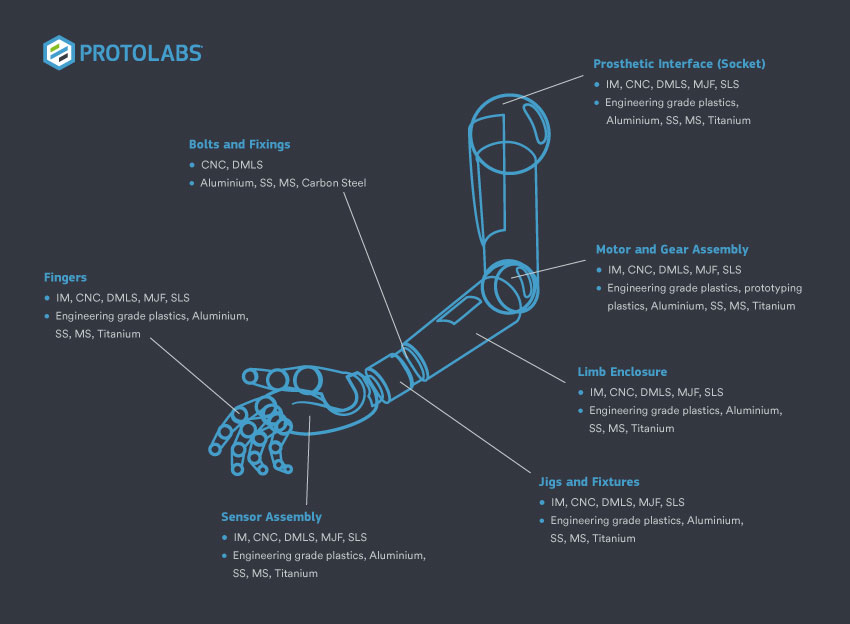
Industry 4.0 and robotics manufacturing
For over a decade, the manufacturing sector has been undergoing a rapid digital transformation as sensors, internet-connected devices and cyber-physical production systems (CPPS) are increasingly deployed on the shopfloor.
CPPS systems are considered as the main driver of the fourth industrial revolution (Industry 4.0) in manufacturing.
They digitise physical processes and enable their optimisation by means of cutting-edge technologies like Big Data, Artificial Intelligence, and the development of powerful digital twins.
This rapid shift has had a significant impact on how products are manufactured, and in some cases lowering the barrier to entry for smaller original equipment manufacturers (OEMs) and reducing investment costs. This is a benefit for the development of robotics where smaller teams can now more competitively compete against traditional larger players.
In this chapter, we examine the cutting-edge systems and technologies that enable the acceleration of the robotics industry. We look at how digital manufacturing is accelerating the industry through its ability to offer increased accessibility to the manufacturing processes necessary to advance robotics including 3D printing, CNC machining, and injection moulding.
Industrial Robotics as an Innovation Driver
Industrial robots are one of the most prominent types of CPPS systems. They comprise physical parts that carry out field automation processes, yet they are controlled by digitally enabled data-driven applications. Industrial robots are usually deployed to automate the following two types of manufacturing tasks:
- Repetitive tasks, such as painting, palletizing, and product assembly. Industrial robots are faster and more efficient than humans in performing such processes. This is because the corresponding manual tasks are usually tiring, cumbersome and error prone.
- Hazardous tasks, such as materials handling, arc welding, and CNC monitoring. Such tasks require human workers to work in harsh environments, to perform dangerous tasks, or even to deal with hazardous substances.
Industrial robots are contributing to more flexible, scalable, and efficient production processes. Contrary to human workers, they work 24×7 in fast, safe and cost-effective ways. Nowadays, they are commonly deployed to support many different automation processes on the factory floor.
Industrial robots are also perceived as one of the most powerful ways to automate and build flexible production lines that enable customised production models like made-to-order and engineering-to-order. The latter model leads to mass customization i.e., the ability to produce highly customised products with only marginal increase in production cost.Industrial robots can automatically reconfigure production lines to produce alternative product variants with limited, or even zero, human intervention. Nevertheless, this flexible manufacturing approach is gradually reaching its limits, as radically differentiated products require changes, not only in the configuration of the production line, but also on the machinery used, especially when there is a need to manufacture a new product. Designing the production system of a new product requires efforts that are orders of magnitude higher than producing a variant of an existing product.
The need to overcome this barrier drives a novel use of industrial robots: using manufacturing robots to produce a new machine in order to achieve unprecedented scalability and efficiency in production. During the last couple of years, industrial robots are increasingly used to build parts of machines or even entire industrial machines from scratch. To this end, industrial robots leverage digital models of the machines and emerging technologies like additive manufacturing.
Manufacturing as a Service: When the Machine Makes the Machine
A key enabler of the advancement of robotics innovation is the leveraging of digital models to enable the manufacturing as a service (MaaS) paradigm. MaaS or digital manufacturing platforms offer access to various manufacturing processes, such as 3D printing, CNC machining, and injection moulding, and provide an easy transactional experience by allowing customers to upload their part designs to quickly get quotes for manufacturing costs and lead times.
Digital manufacturing opens access to cutting edge manufacturing processes for design teams of any size, with low investment costs, transparent lead times and design and iteration support.
Robotics-based manufacturing models deliver:
- Flexibility, as it can enable the development of diversified machines with minimal human involvement.
- Resilience, through easing production repurposing and facilitating the development of effective manufacturing responses to fluctuations in demand, as well as to supply chain disruptions.
- Scalability, as it helps alleviate the bottleneck of developing new machinery.
- Supply chain efficiency, through enabling supply chain stakeholders to instantly access data models of machines or of their parts.
Advantages of Digital Manufacturing for Robotics
Rapid, accessible prototyping
Digital manufacturing can allow for the remote design and development of robotic prototypes, as well as remote testing and evaluation of those prototypes. This can allow for faster development cycles, as well as the ability to test prototypes in a variety of different environments. Having parts shipped and ordered enables development teams across the globe to access quality manufacturing.
Access to advanced manufacturing technologies
Digital manufacturing provides access to advanced manufacturing technologies, such as metal 3D printing and CNC machining.
![]()
Data-driven design
Digital manufacturing can enable the collection and analysis of large amounts of data on the performance of robotic systems. This can be used to inform the design process and improve the performance of the final product.
Collaborative design
Digital manufacturing can allow for collaboration between designers, engineers, and other stakeholders, regardless of their location. This can enable real-time communication and collaboration on the design of a robot, which can lead to more efficient and effective development. Some digital manufacturing platforms offer a design portal that all stakeholders can access and contribute to, further accelerating the design and development phase.
Cost reduction
Digital manufacturing can reduce the cost of robotic design and development by offering low-volume prototyping and fixed material costs pricing models.
Key manufacturing processes delivered through Digital Manufacturing: 3D printing, CNC machining and injection moulding
3D printing enables manufacturers to build parts by joining materials layer by layer based on a computer aided design (CAD). Within robotics manufacturing, 3D printing has created new ways of designing that allows for rapid, affordable prototyping and design iterations using end-product materiality for accurate testing.
3D printing also edges closer to a method of deploying robotics at scale and on-demand.
3D printing offers endless possibilities regarding geometries and materials that other services potentially can't provide, making it an excellent match with the development of robotics projects.
Why 3D printing for the Robotics industry?
- Ability to deliver unique design features
- Quick prototyping
- Design versatility
- Complex geometries, including lattice structures
- Significant weight reduction over other manufacturing processes with the same material
- Waste reductive process (additive rather than reductive)
3D printing can be particularly useful in the the design and manufacture of cameras, motors, sensors, microcontrollers, manipulators, and robotic arms. Further discussed in the materials section, the materials available for 3D printing are expanding. Once limited to a narrow range of plastics, 3D printing is now available in metals, ceramics, and flexible materials.
CNC machining, which includes both milling and turning, is a valuable manufacturing process for robotics development and end manufacturing. Ideal for prototyping and low volume production, automated CNC machines enable robotics developers to order and receive parts, sometimes within just days. CNC also offers tighter tolerances than other services, and its 5-axis process provides high complexity and variation, important for applications that demand precise, repeatable movements. Finally, the service allows for controlled surface finishes, which are needed for low-friction components in interactive parts. These aspects make CNC machining perfect for the highly customised parts at low volumes that robotics often requires.
Why CNC machining for the Robotics industry?
- Precision parts (important as parts need to fit together perfectly - critical for the proper function of a robot)
- Strong, durable materials
- Can be used to create complex shapes - allows for greater design flexibility
- Fast and efficient
- Surface finishes - good for low friction parts required for interacting
- CNC machining is a good fit for the manufacture of gears, end effectors, custom fixtures, motor and components among others.
Injection moulding can be used for plastics, liquid silicone rubber, as well as overmoulding and insert moulding. It offers a repeatable option when larger-scale production is required. It can be a more cost-effective option for larger quantities as the same mould is used for each part, and the parts are consistent and precise. But new methods of injection moulding are also enabling prototyping and testing. While it is not the key process used for producing robotic components, it is commonly used for production of housings, frames, casings, gears and camera mounting frames. Further, the liquid silicone rubber (LSR) process is increasingly used with the introduction of soft robotics.
Why injection moulding for the Robotics industry?
- Precision components
- Repeatability
- Light-weight (plastic parts) Scalability
- Rapid prototyping
Digital manufacturing eases the deployment of 100s of robots in the manufacturing shop floor, while facilitating their collaboration towards end-to-end automation.
Furthermore, digital manufacturing enables scalable on-demand automation in-line with the pay-as-you-go paradigm. At the same time, 3D printing and CNC machining lays a foundation for robotic machines to manufacture other robotic machines automatically and quickly. This is a starting point towards hyper-automated and scalable manufacturing systems that can build their own components based on the concept of “machines that build machines”.

Manufacturing Robotics Report
An Engineer’s guide to understanding the state of the art in hardware, materials, and the future of robotics manufacturing.
Download the eBook Request your printed copy
















